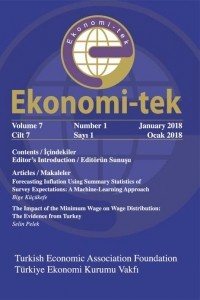
Ekonomi TEK
Yazarlar: Hans J. BLOMMESTEİN
Konular:İktisat
Anahtar Kelimeler:Risk-Free Rate,Safe Assets,Sovereign Risk,Mispricing,Sovereign Issuers
Özet: This paper seeks to dispel or at least reduce the confusion surrounding the related key concepts of the risk-free rate, safe assets, and sovereign risk, which are central to policy and academic discussions. This confusion gives rise to a lack of consensus as to how to define, measure, and price “sovereign risk,” thus creating a major obstacle to assessing sovereign borrowers’ stress. In this paper, safe assets are considered to be those that are virtually default-free. These so-called safe assets function as “information-insensitive” instruments (they serve as “money” and have the associated basic functions of money, such as collateral and backing of checkable deposits of commercial banks and money-market funds). The return on these assets is the (relatively) risk-free rate. The pricing of risky assets involves assessing or evaluating the risk dimensions of relative asset safety. A significant complication in carrying this out is the fact that the market is often driven by emotions, or animal spirits. Sometimes these market emotions change rapidly, having a knock-on effect on the (mis)pricing of relatively safe assets and sovereign risk. The track record of sovereign-risk pricing is not very impressive, characterized by prolonged periods of risk under-pricing (excessively compressed spreads) followed by risk overpricing (sudden widening of spreads). Market measurements (including ratings) thus seem somewhat unreliable. One should, therefore, be extremely cautious in concluding that the sovereign debt of an OECD country has indeed lost its “risk-free” status. At the same time, the overarching strategic objective of debt managers is to raise funds at the lowest possible cost within the boundaries of a preferred risk level. This implies for the sovereign borrower a two-part goal: issuing (relatively) risk-free sovereign debt and preserving this relatively risk-free status. Reinforcing government borrowers’ focus on this strategic objective is the knowledge that a steady supply of safe sovereign assets is essential for the smooth functioning of the worldwide financial system (for allocating resources, pricing benchmarks, and as a collateral source). Clarity and consistency are necessary conditions for the proper pricing of sovereign risk. Beyond that, the proper pricing of sovereign risk has implications for the economy as a whole (via the impact on risk-weight rules for capital adequacy of banks, posting sovereign debt as collateral, the pricing of bonds issued by banks and other non-governmental entities). The transition from a (relatively) “risk-free asset” to a (relatively) “risky asset” has therefore major macro and micro financial ramifications.